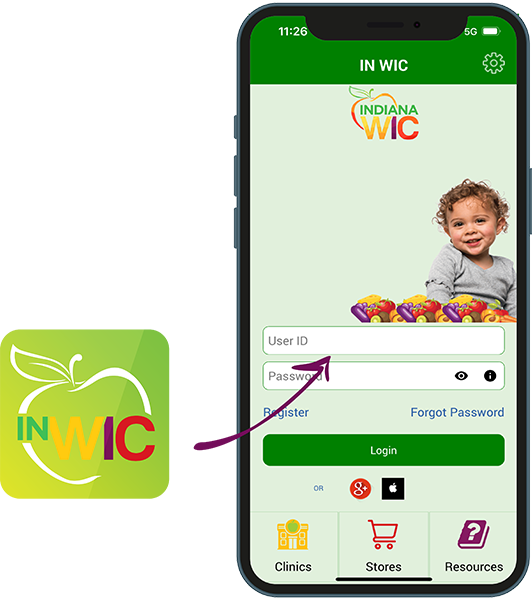h2 hide
¿Qué es el WIC?
El WIC es un programa de nutrición que tiene como objetivo ayudar a mujeres embarazadas y puérperas, bebés y niños a alimentarse bien y mantenerse saludables.
¿Quiénes pueden participar?
- Mujeres embarazadas;
- Puérperas (hasta seis meses después del parto);
- Madres que amamantan (hasta un año después del parto);
- Bebés (menores de un año);
- Niños menores de cinco años.
Debes vivir en Indiana y cumplir con las pautas de ingresos, que se encuentran en el reverso de este folleto o en wic.in.gov.
¿Qué proporciona el WIC?

- Alimentos saludables elaborados para satisfacer necesidades especiales de nutrición, además de beneficios en productos frescos de temporada para comprar a los agricultores locales.
- Análisis y evaluación de la nutrición y la salud.
- Educación y asesoramiento nutricional.
- Apoyo a la lactancia, que incluye que las madres que amamantan a sus hijos reciban alimentos nutritivos adicionales del WIC, apoyo individual de consejera de madre a madre y acceso a profesionales de la lactancia.
- Referencias a otros servicios de salud, familiares y sociales de Indiana.
¿Cómo funciona el WIC?
- Leche y productos lácteos
- Frutas y vegetales
- Huevos
- Cereal
- Granos integrales (pan, arroz, tortillas)
- Tofu
- Comida para bebés
- Fórmula infantil
¿Por qué debes usar la aplicación INWIC?


Elegibilidad según los ingresos
Las familias que ya reciben Medicaid, beneficios del Supplemental Nutrition Assistance Program (SNAP, Programa de Asistencia Nutricional Suplementaria) o beneficios del Temporary Assistance for Needy Families (TANF, Programa de Asistencia Temporal para Familias Necesitadas) son elegibles según los ingresos para el Programa WIC.
Tamaño del hogar*
Ingresos anuales hasta $ (total antes de deducciones)
1
2
3
4
5
6
7
8
Ingresos mensuales hasta $ (total antes de deducciones)
1
2
3
4
5
6
7
8
Ingresos semanales hasta $ (total antes de deducciones)
1
2
3
4
5
6
7
8
Si estás embarazada, puedes contarte como dos (2) personas.
En el caso de los hogares con más de 8 miembros, agrega $8732 en ingresos anuales por cada miembro adicional.
* “Hogar” se refiere a un grupo de personas (relacionadas o no) que viven como una unidad económica.
Las familias que ya reciben Medicaid, SNAP o TANF cumplen con los requisitos de ingresos para participar en el programa WIC.
Elegibilidad según los ingresos
| Tamaño del grupo familiar* | Ingresos anuales, hasta $ (total sin deducciones) |
Ingresos mensuales, hasta $ (total sin deducciones) |
Ingresos semanales, hasta $ (total sin deducciones) |
|---|---|---|---|
| 1 | $27.861 | $2.322 | $536 |
| 2 | $37.814 | $3.152 | $728 |
| 3 | $47.767 | $3.981 | $919 |
| 4 | $57.720 | $4.810 | $1.110 |
| 5 | $67.673 | $5.640 | $1.302 |
| 6 | $77.626 | $6.469 | $1.493 |
| 7 | $87.579 | $7.299 | $1.685 |
| 8 | $97.532 | $8.128 | $1.876 |
Si estás embarazada, puedes contarte como dos (2).
Para grupos familiares que tienen más de 8 miembros, suma $9.953 de ingresos anuales por cada miembro adicional.
* Grupo familiar se refiere a un grupo de personas (que tienen o no un parentesco) que viven como una unidad económica
Para obtener más información o encontrar una clínica cerca de ti, envía un correo electrónico a inwic@health.in.gov, llama al 800-522-0874 o visita nuestro sitio web wic.in.gov.